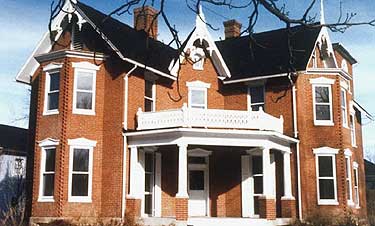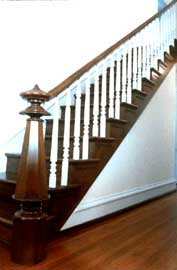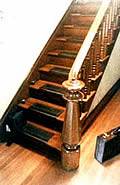



no.6
 If it was unpainted
historically, DON'T paint it! If it was
painted historically, DON'T strip it!
If it was unpainted
historically, DON'T paint it! If it was
painted historically, DON'T strip it!
::issueFOCUS:: Obscuring historic interior finishes
::go to REHAB YES'S::
|
[TOP IMAGE] House with intact interior. NPS Photos.
The historic character...
The historic character...The interior of this late 19th-century Gothic-Revival
style house had survived with a remarkable degree of integrity. Doors
and their surrounds, window sash and trim, stair balusters, parquet flooring,
baseboards and floor moldings, mantels, built-in cabinetry (bookcases
in the living room and clothes cupboards in the bedrooms, a decorative
transom screen, and original wood curtain rods) were all intact. Together,
the interior features and the way they were finished contributed to the
distinctive character of the house, and were typical of Victorian Gothic
house interiors of the period.
...and how it was lost in the rehabilitation.
The rehabilitation of the house for continued use as a single-family residence
consisted primarily of work to update the kitchen and bathrooms, mechanical
systems and utilities, and included some cosmetic refurbishing of the
interior. In an effort to "brighten up" the historic interior
and make it more compatible with contemporary life-styles, all the previously
unpainted wood trim was painted white. Because the existing interior trim,
with its unpainted natural-colored finish, was such an important feature,
painting it white resulted in a dramatic change to the historic character
of the house. The woodwork—and its typical tone and grain—had
also underscored the sense of time and place associated with the historic
district. Changing its appearance substantially altered the character
of this virtually intact late 19th-century house, and, as a result, the
work failed to meet Standards 2 and 5.
What should you know?
Interior features are important in determining the overall character of
historic buildings. This includes the architectural and decorative features
themselves, as well as the manner in which they are finished. Applying
paint to traditionally unpainted interior surfaces can change a building's
historic character as quickly as removing paint from traditionally painted
surfaces. Either approach does not meet Standards 2 and 5
of the Secretary of the Interior's Standards for Rehabilitation.

After rehab: white paint.
Standard 2: The historic character of a property shall be retained and preserved. The removal of historic materials or alteration of features and spaces that characterize a property shall be avoided.
Standard 5: Distinctive features, finishes, and construction techniques or examples of craftsmanship that characterize a property shall be preserved.

